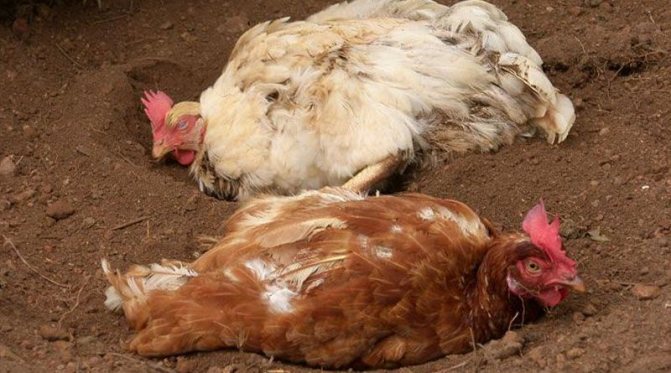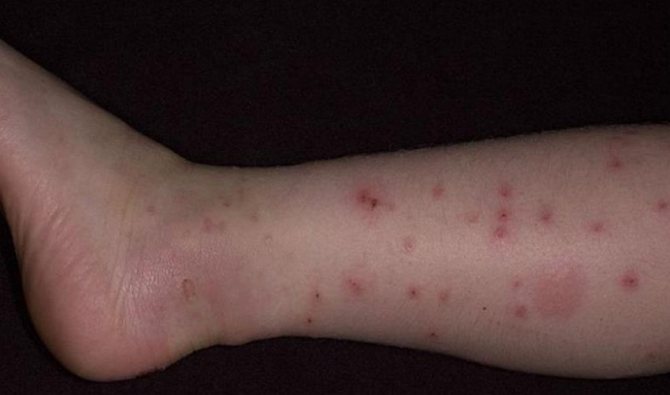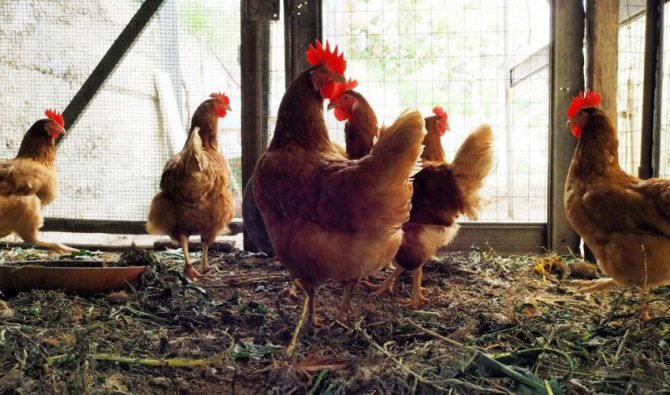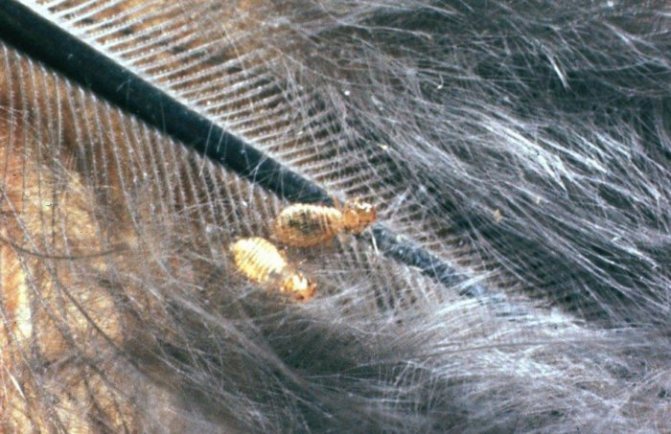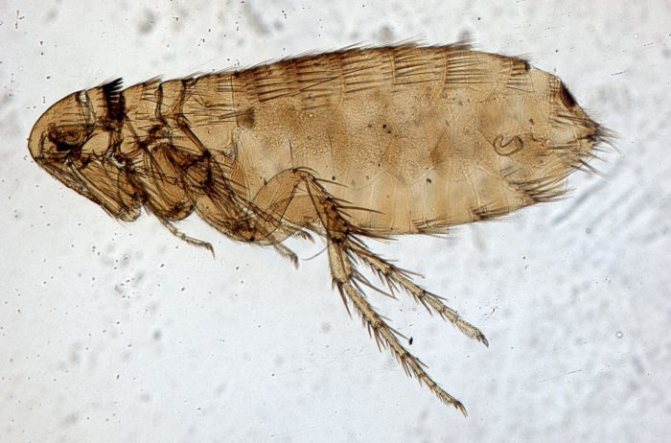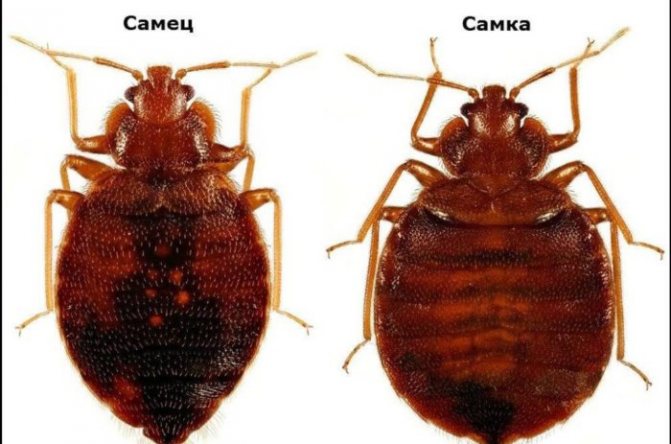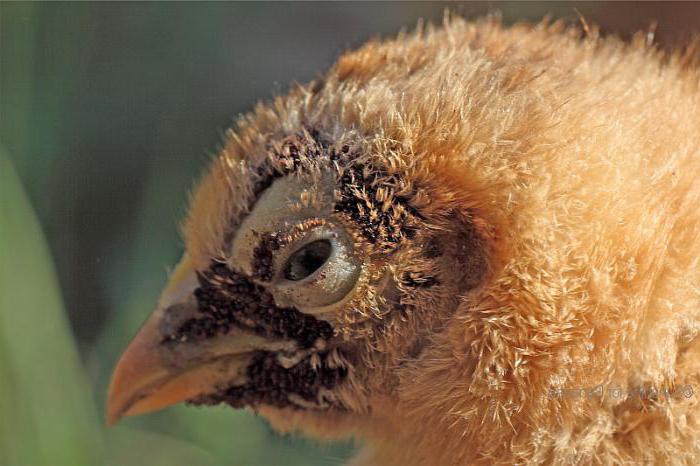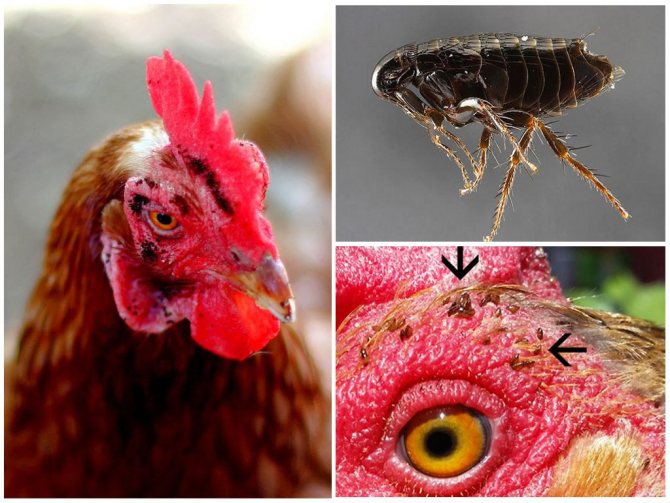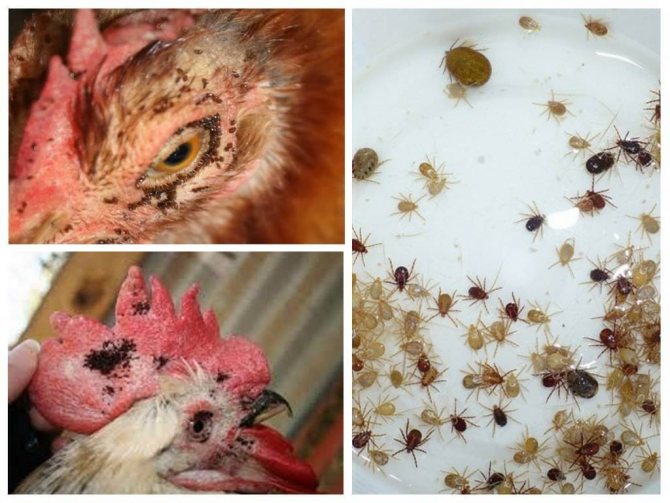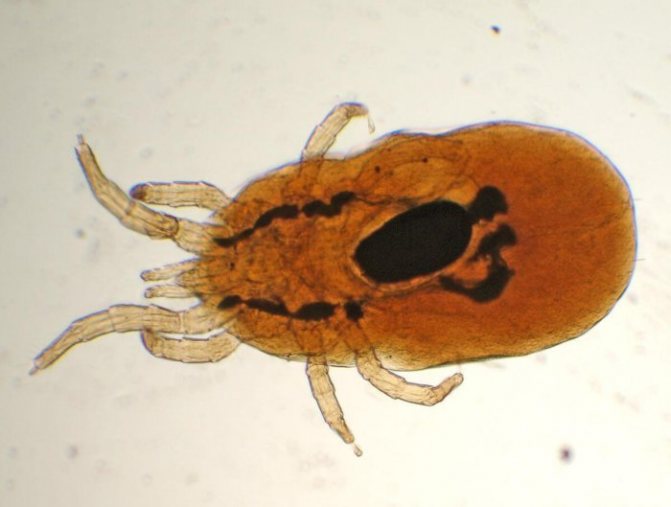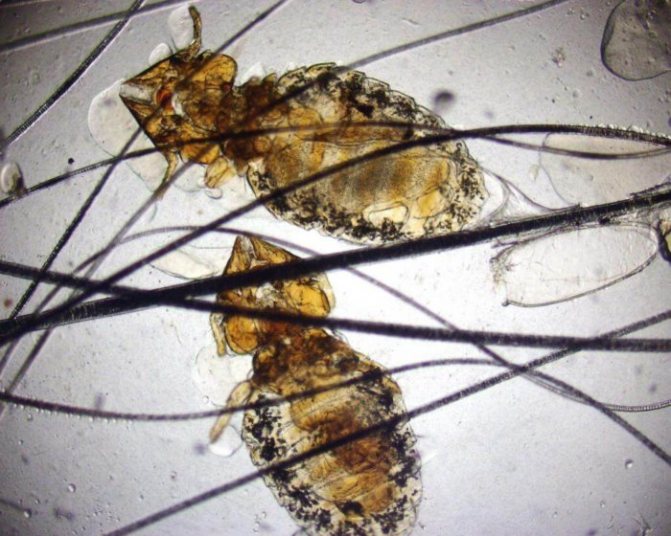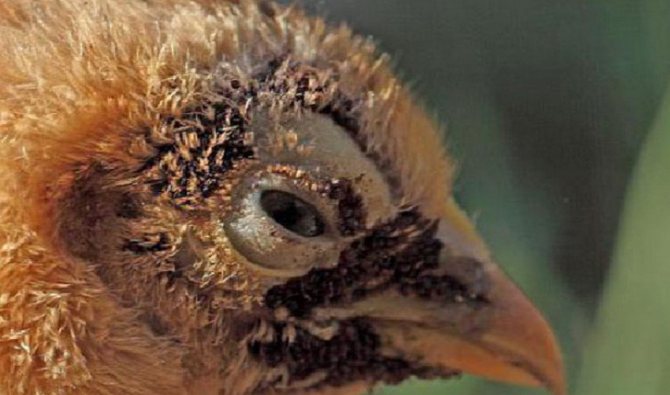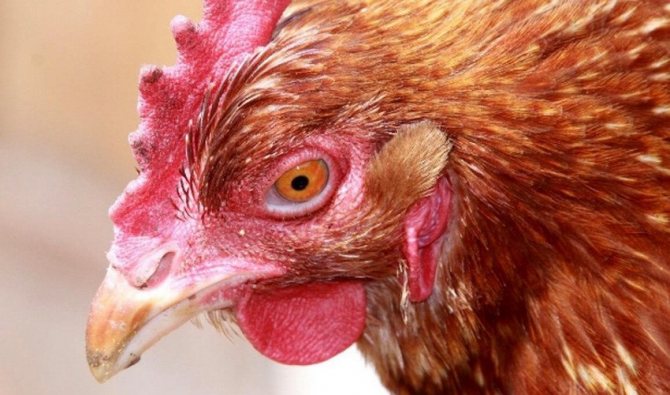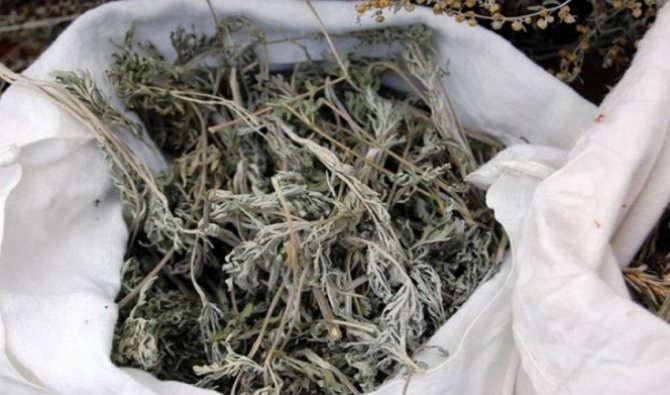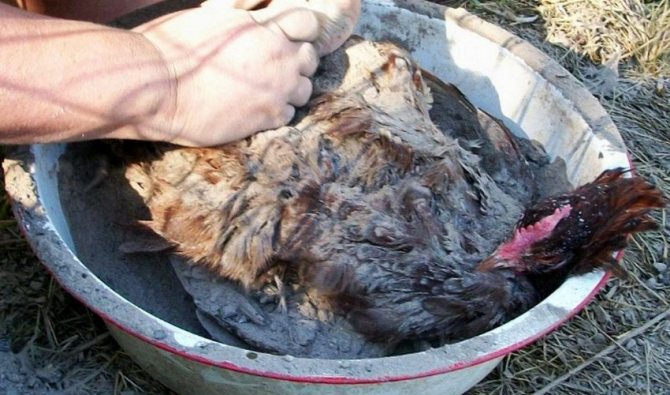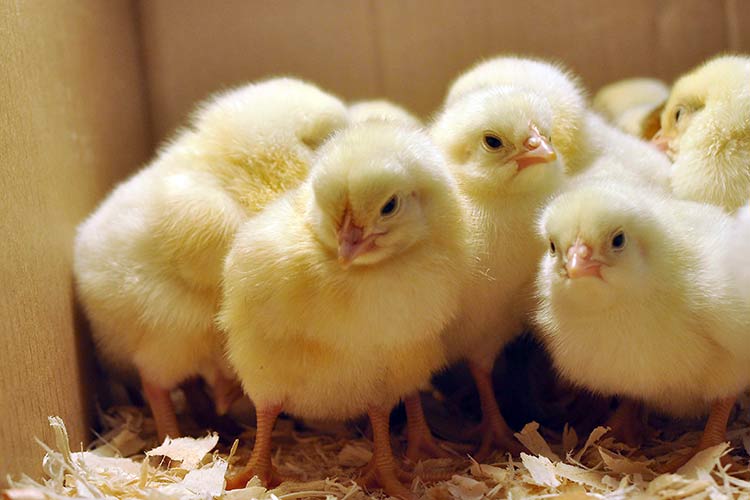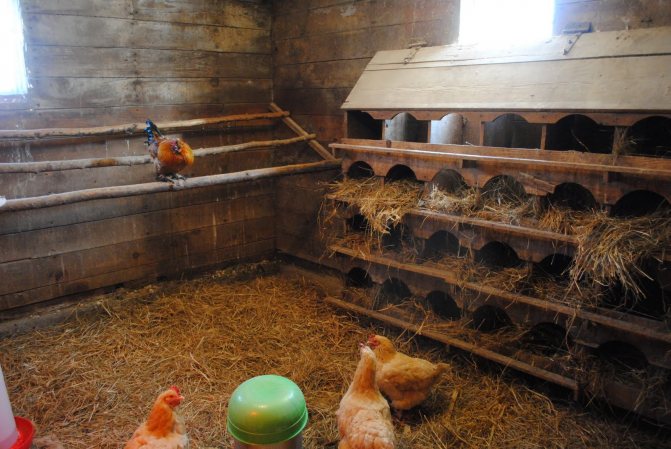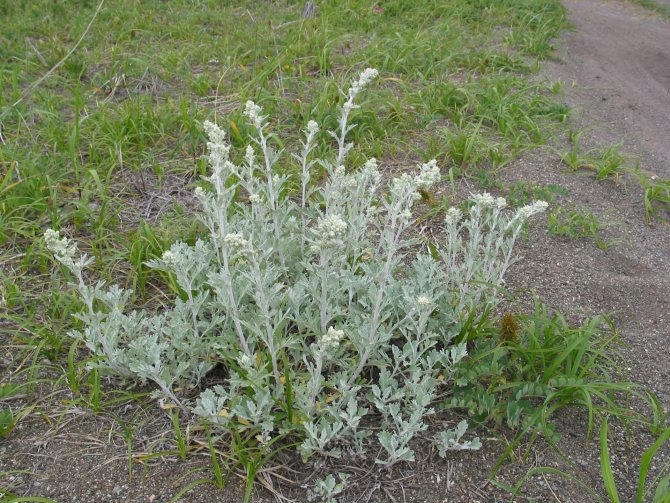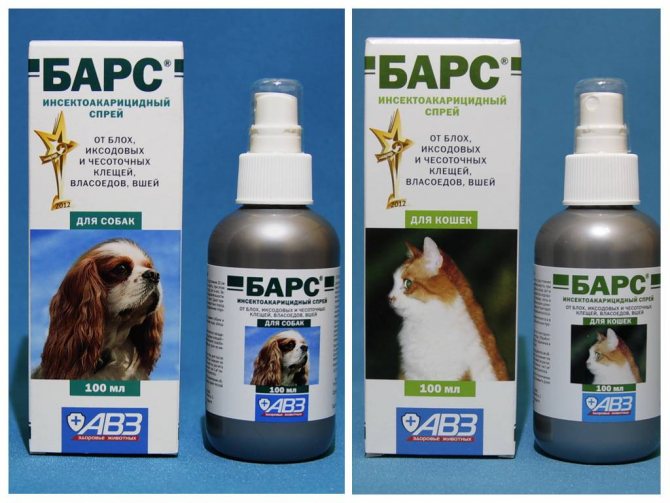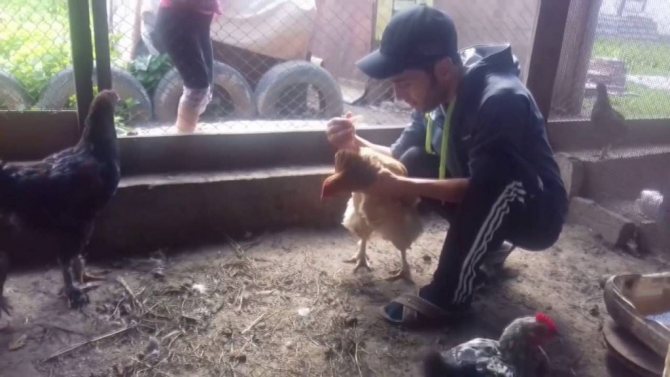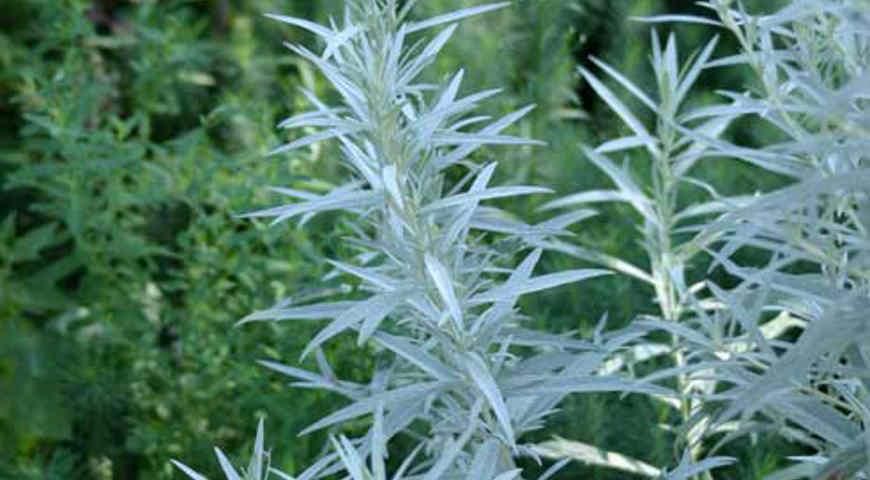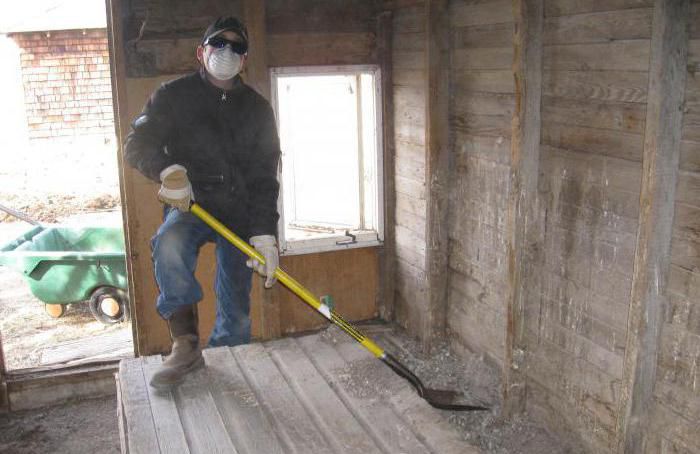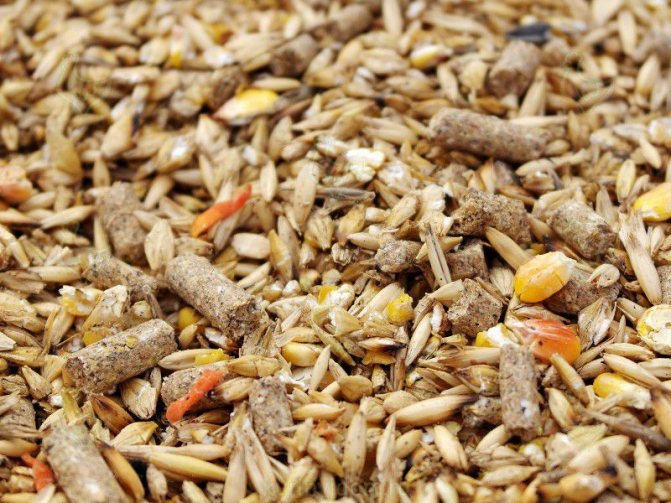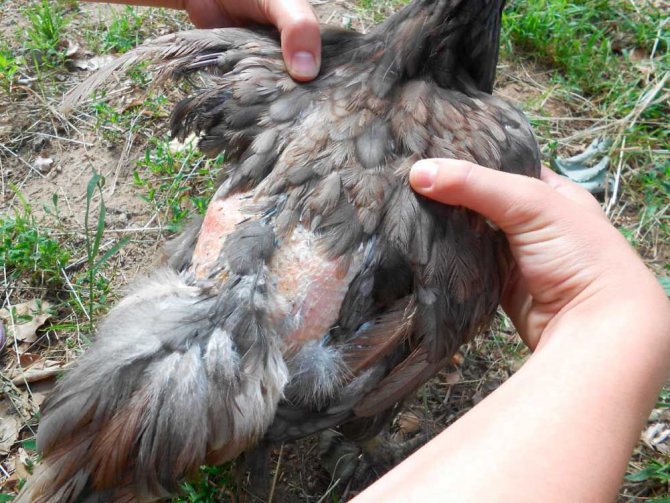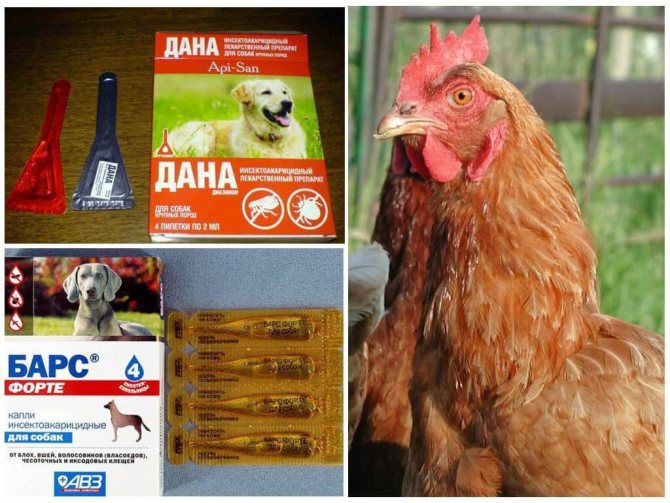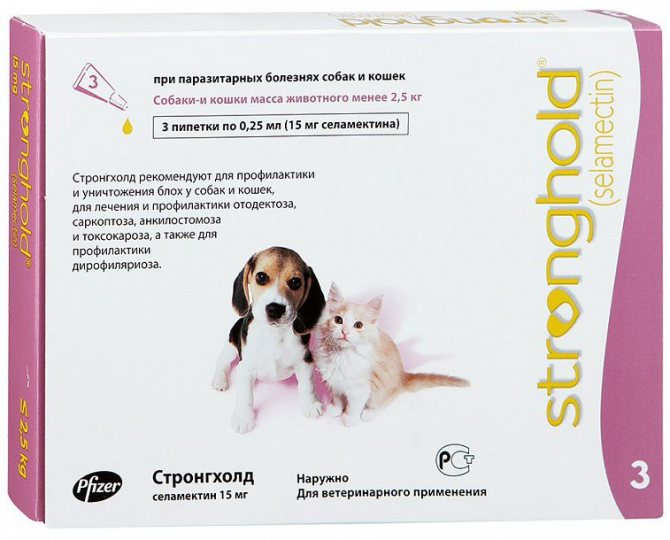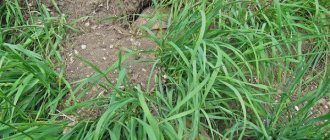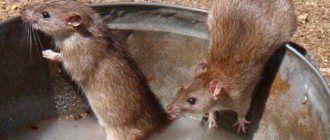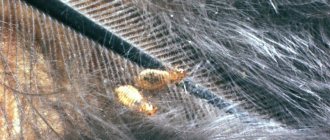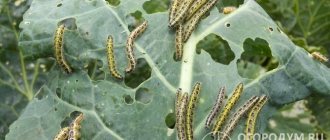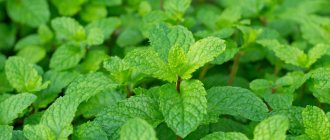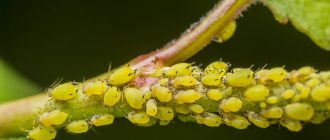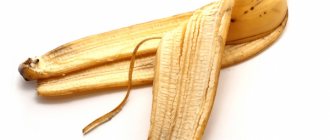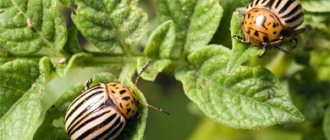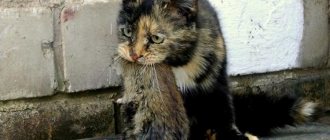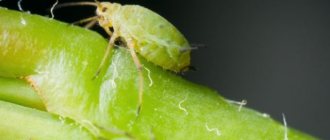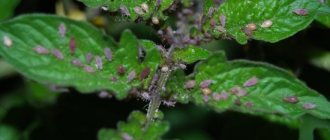- Chicken coop processing
Chicken fleas cause a lot of trouble for poultry owners: the growth of young animals stops, the egg production of chickens decreases, they lose weight, become vulnerable to infections and may die. The solution to the question of how to get rid of chicken fleas is urgent, because not only the life of poultry and the material well-being of the farmer is at stake, but also the health of people living nearby.
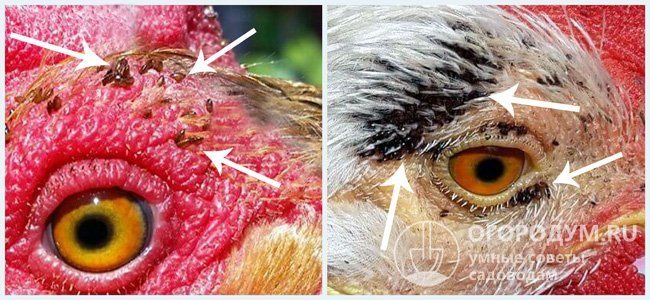
Chicken fleas around the eyes of birds (parasites from above look like narrow lines. Their body is completely flat (flattened from the sides), the color is dark brown)
The appearance and features of chicken fleas
The flea is a blood-sucking parasite that settles in the feathers of a bird and feeds on its blood. Outwardly it resembles a louse, but there are no wings, so it cannot fly. But it jumps well, which allows it to spread quickly. The insect is so small that it is visually difficult to distinguish on the bird. The body is flattened, elongated, about one and a half millimeters long. Insects are dark in color, with color variations from red to brown. The difference from an ordinary flea is the presence of antennae and a dense carapace.
Chickens are attacked in numerous colonies of hundreds of individuals. They are firmly fixed on the skin, which allows them to parasitize on the selected victim for a long time. Fleas are able to live comfortably at a temperature of 40 C. When they get on the body of another animal (cow, pig, pig) or a person, they quickly die.
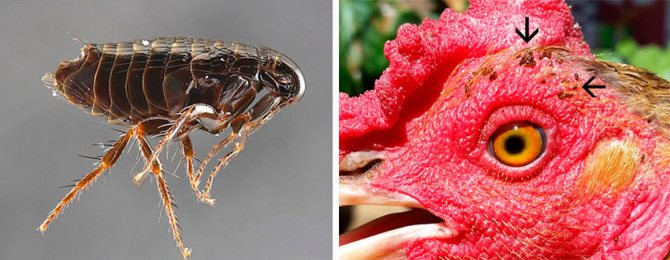

The first photo shows the appearance of a flea, on an enlarged scale. Here, the developed hind limbs are noticeable, with which it pushes off and jumps, up to one and a half meters in length. In this way, she moves.
In the second photo, fleas on the chicken are clearly distinguishable, due to the large number. A similar phenomenon is typical in especially advanced cases.
Poultry infection symptoms
Visually, you can determine if there is fleas in chickens... It is enough to observe the behavior of the bird. When infested with fleas, there are the following symptoms:
- Chickens itch all the time.
- Pluck out feathers and fluff.
- They are rapidly losing weight.
- Egg production decreases or is completely absent.
- The bird is sluggish, moves little.
- Lack of appetite.
If these signs appear, it is worth examining the chickens. Look under the wings, under the tail or belly. Insects are easy to see if they are. The danger of the appearance of chicken fleas is that they provoke anemia, scabies, exhaustion. In addition, parasites are carriers of diseases such as brucellosis, salmonellosis, and so on.
Why are chicken fleas dangerous for birds and humans? The danger from infection of poultry is that there is sustained stress, irritability in pets. They pluck out their feathers, comb their skin. If the affected area is large, it causes wasting. Chicken does not eat, loses muscle tissue, fat layer.
The result is always the same - the death of the bird. But this does not happen so often. Not a single conscientious owner will bring the matter to such an outcome. Meat and egg productivity suffers more often. The development of young animals also slows down.Broilers lose body weight every day. The sad picture is complemented by the fact that fleas infect animals and humans with dangerous diseases.
If there fleas in chickens, then the insides are also affected by helminths. The closed housing of poultry only exacerbates all these problems. Fleas are not dangerous to humans, the insect cannot bite through the skin. The parasite also needs a temperature of about 40 degrees, so people can only be an intermediate link in the search for a permanent host.
Life cycle and behavioral features
Unlike other species of fleas, chickens are not able to live long outside the body of the victim. That is why the parasites tend to settle down as much as possible in the chosen territory, without the possibility of further migration. They can settle near chickens, for example, under the bedding.
Insects are dependent on the temperature regime of their habitat. Able to endure short-term discomfort while jumping to another object. For a long stay, a person is not suitable for them, since the temperature is lower and the epidermis is thicker (unable to bite).
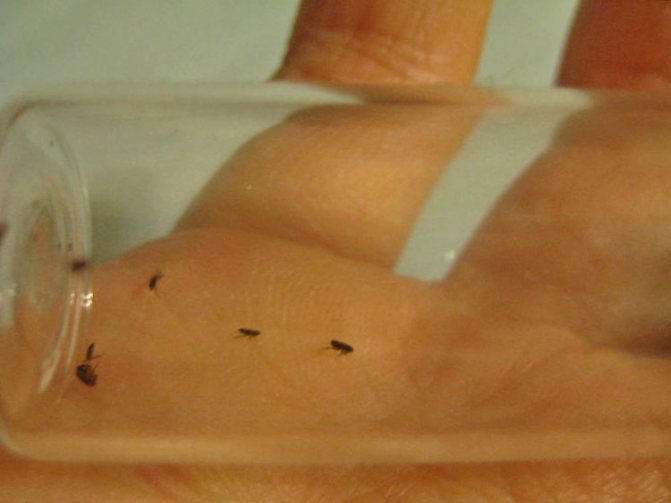

In a hen house, flea breeding is possible if:
- Sanitary standards are not supported: there is no ventilation, it is dirty, bedding does not change for a long time.
- High humidity and temperature in the room.
- There is no scheduled disinfection.
Getting into such a favorable environment, they multiply intensively in a few days. Females leave egg clutches daily, while scattering them on the sides with their hind legs. Thus, they seek to expand the settlement zone. As a result, the chicken coop is littered with white microscopic capsules. Of these, larvae soon hatch, quickly turning into adults.
The life cycle of a flea is about a year.
Signs of infection in females
You can understand that a bird is infected with ticks on several grounds. Parasites can be seen in different parts of the house - on the walls, under the perches, in the cracks in the floor.
If the bird has become inactive, experiences severe itching, egg production has decreased, the young are gaining weight poorly, the plumage condition has worsened or bald spots appear on the body, it is most likely that the chickens are infected with ticks.
Pay attention to the behavior of the feathered wards. If the chickens began to clean their feathers more often, pluck out feathers under their wings, in the area of the cloaca, constantly take "sand" baths - this may also indicate an infection with feather, itch mites.
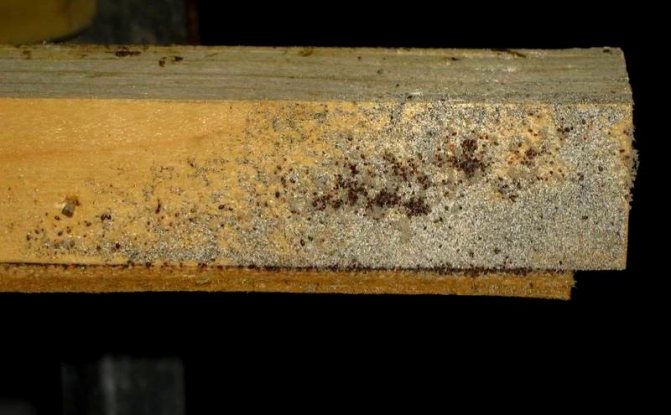

Ticks in the chicken coop
Other symptoms when chickens have ticks:
- weakness, apathy;
- wounds, scratches, sores on the body;
- dry frequent cough, shortness of breath;
- pallor of mucous membranes, comb, earrings;
- lack of egg production in laying hens;
- weight loss;
- refusal to eat, increased thirst.
Upon closer inspection, you can see small red or black specks, small grains, blood droplets on feathers, the body of birds or on the walls of chicken coops, perches.
You can find a tick by placing material from a nest, perch, chicken coop on a white sheet of paper and examine it in bright light. It is best to take the material in the evening, at night.


Acarimorph mite
Having determined that the bird is infected with ticks, you need to immediately get rid of the blood-sucking parasites, because under favorable conditions they multiply very quickly, and the invasion can become a real problem, which will result in large financial losses. Even if the tick lives only on one chicken, over time, if the bird is not cured and ectoparasites are not removed, the entire chicken population will be infected.
Signs of fleas in chickens
A chicken infestation with fleas is diagnosed by a number of symptoms:
- egg production decreases;
- there is anxiety in the behavior of chickens;
- weight is lost despite a great appetite;
- peck and bite themselves, itch, run constantly;
- bald patches appear on the feather cover;
- near the eyes, the ridge, brown crusts are noted - parasitic accumulations that have multiplied in large numbers.
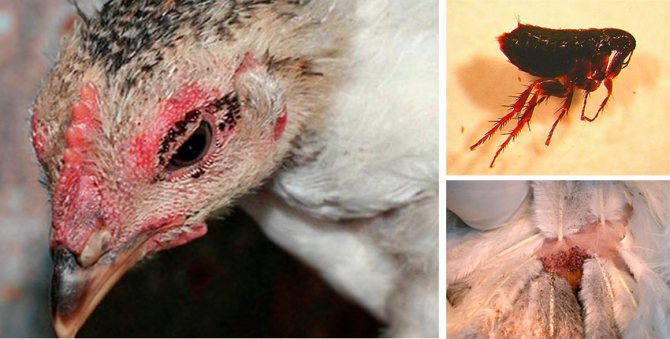

At the initial stage, it is problematic to detect pests. It is recommended to regularly inspect the bird population, especially the skin: raise the feather and carefully examine. In the absence of treatment, birds develop anemia, which is why they soon die.
Damage: why are chicken fleas dangerous?
By themselves, fleas are harmless to humans and other mammals, since their blood does not suit them. In rare cases, the parasite can bite, but the wounds are superficial, since the thickness of the epidermis does not allow getting to the capillaries.
For chicken livestock, this type of pest is dangerous as a carrier of infectious diseases:
- Bruce's disease (brucellosis);
- salmonellosis;
- sleeping sickness;
- encephalitis.
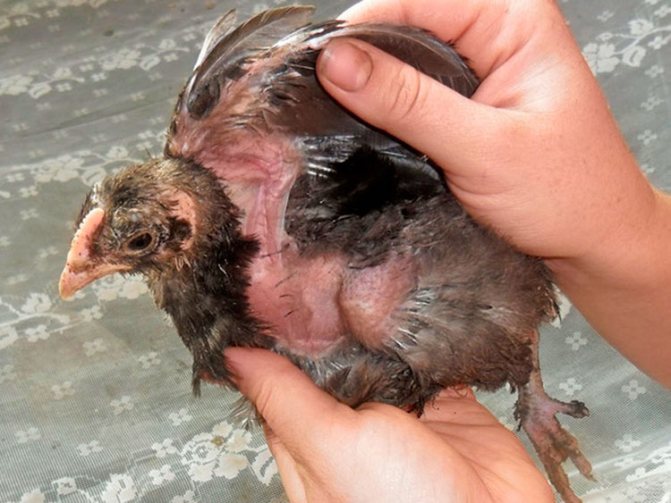

Diseases that can be transmitted to humans through tactile contact with a sick chicken, often fatal. Eating eggs and meat from infected specimens is strictly contraindicated. From this side, fleas can pose a serious danger to humans.
Against the background of the colonization of fleas, the appearance on feathered lice, which are the cause of the mass incidence of head lice, is possible.
Danger of bird mites to humans
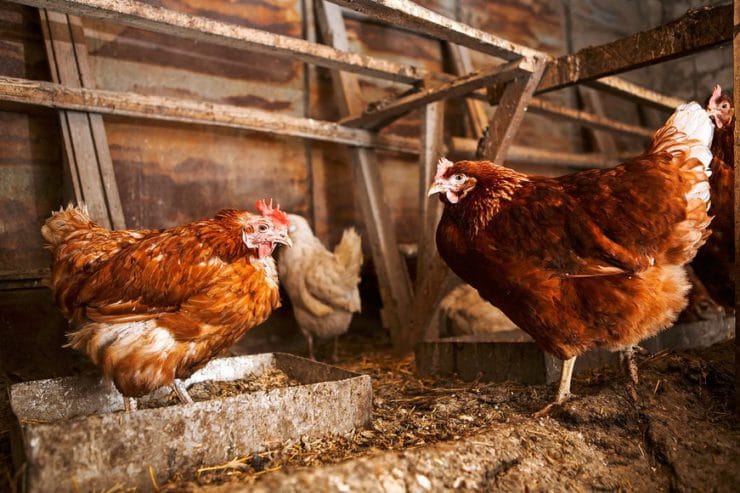

The main harm that these tiny creatures cause to humans is financial losses. Infected birds, which often die, a decrease in egg production, the cost of deacarising a chicken coop - all this can hit the breeder's wallet hard.
At the same time, there is another danger that these ectoparasites pose to humans. In times of famine, when ticks cannot find the main host for food, they can attack a person. Rashes and severe itching occur at the site of the bite. To date, there is no officially confirmed data that these parasites can cause the development of any infectious diseases, but one must try to avoid contact with them.
Sometimes parasites invade living quarters. In an apartment or house, they can be found in pillows filled with feathers.
Parasite control methods
Fleas must be dealt with immediately, so as not to incur financial losses. Birds on their own are not able to cope with attacking parasites, therefore, countermeasures from the outside are necessary. The process of extermination is labor-intensive and lengthy, subdivided into 2 successive stages: disinfection of the poultry population, then the chicken coop.
Different means are used:
- chemical;
- folk.
To avoid an epidemic, sick chickens are separated from healthy ones. The vacated barn is treated with insecticidal preparations, which are freely sold at veterinary points. They do general cleaning only first: they wash the floors and walls, throw out old bedding, and remove food residues and droppings. After completing the procedure, nothing is done for a day, then the applied agent is washed off and the feathered guests are populated.
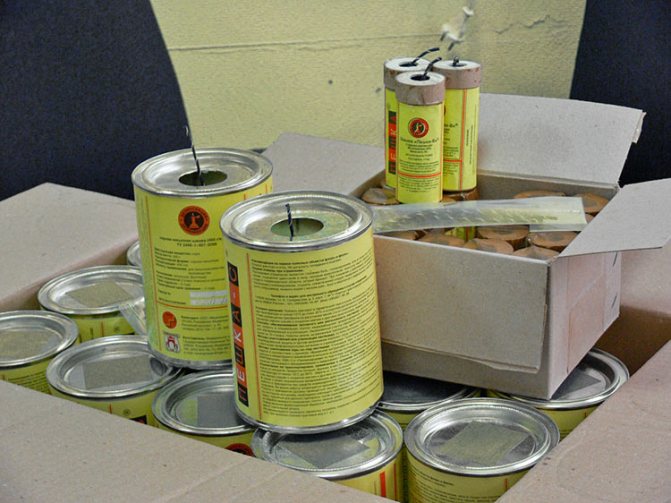

An alternative would be to fumigate the room with a smoke bomb (Pawn-B). One piece is enough for 250 sq.m. Easy to use guarantees complete elimination of body parasites.
Regardless of the method chosen, the bird is subjected to a double treatment, with an interval of 2 weeks. In this case, it is important that the poison does not get inside or on the mucous membrane of the animal.
Getting rid of parasites: an integrated approach
It is possible to get rid of fleas in the hen house and on chickens in a complex way, combining the methods of traditional medicine and disinfestation measures with chemical preparations. A good effect is provided by the observance of preventive standards that prevent infection of birds.
Disinsection of the chicken coop
It is recommended to start the fight against representatives of the flea family by processing the room itself, where the birds spend most of their time. To do this, you can call special services that will process the chicken coop in the safest way, or you can do it yourself. The first method is very costly, so you can resort to the second.
To begin with, all birds are driven out of the room, after which you should get rid of the old litter. It is not recommended to cover such straw in a newly treated barn! You should also get rid of fallen feathers and bird droppings, which may contain waste products of parasites.
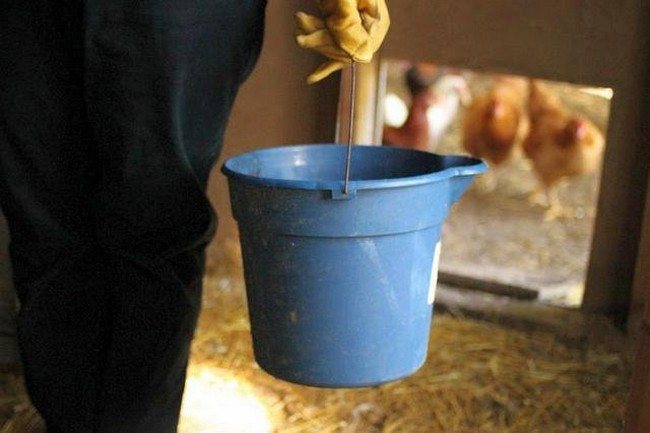

After the preparatory measures, you should put on a protective suit (respirator, gloves, boots) and start processing the walls and floor. To this end, many homeowners use the following tools:
- formalin;
- karbofos;
- incur;
- bleach;
- hydrochloric acid.
The walls with the ceiling are treated with dry or dissolved in water agents and left in this form for several hours. As a result of exposure to active compounds of disinfectants, eggs, larvae and adult parasites die. On the next day, the chicken coop should be well ventilated and only on the third day can new litters be made with the launch of chickens.
Individual bird handling
Flea treatment of chickens should be carried out individually for each bird so that the lice (fleas) do not re-spread. To do this, you can use "Sevin powder", rubbing it into the scalp. Average consumption per bird is up to 15g.
In addition, you can use drops "Feverfew", applying them to the back of the head. Effectively spraying the feather cover of chickens with a solution of "Aversect", evenly applied over the body, bypassing the mucous membranes of the eyes.
What if there are a lot of chickens?
Fighting flea representatives in the chicken coop, where there are a lot of chickens, should also be carried out! For these purposes, healing baths are good, where each of the affected individuals is dipped in turn.
The basis of therapeutic baths is pure and cool water (100 l), in which Butox is dissolved (90 ml). Before use, the solution should be infused for 20 minutes, after which you can start bathing. To do this, each of the chickens is alternately lowered into a volumetric container by 2/3, making sure that water does not enter the animal's mouth.
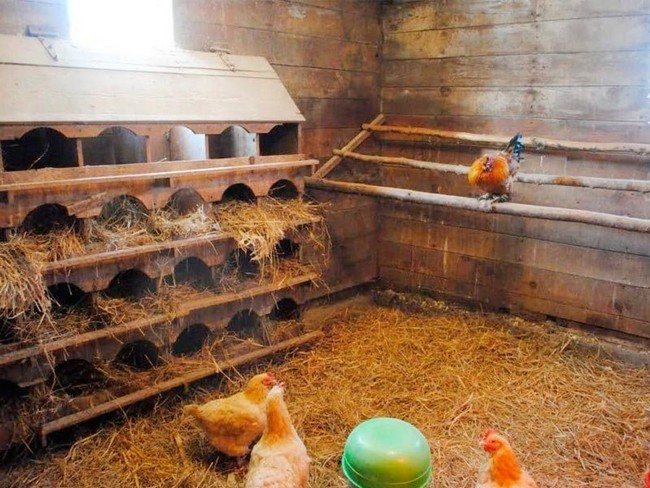

Before the bathing procedure, the chickens should be well fed and watered so that the birds do not start drinking the Butox working solution, which can cause poisoning in their body.
When the birds are immersed in water, the disinfectant solution will penetrate the fleas, causing them to die. Each chicken should be kept in water for up to 20 seconds, during which the ectoparasites living on its skin will begin to die. The used solution should be poured away from the area where animals are walking.
Preventive measures
Prevention of flea skin lesions is a condition for healthy growth of birds at any age. Measures to protect the chicken coop from damage by parasitic insects are:
- timely processing before settling in the hen house of new "layers";
- the fight against rats and mice that have penetrated into the barn and carry ectoparasites;
- isolation for subsequent treatment of affected individuals;
- regular cleaning of the external and internal territory of the chicken coop.
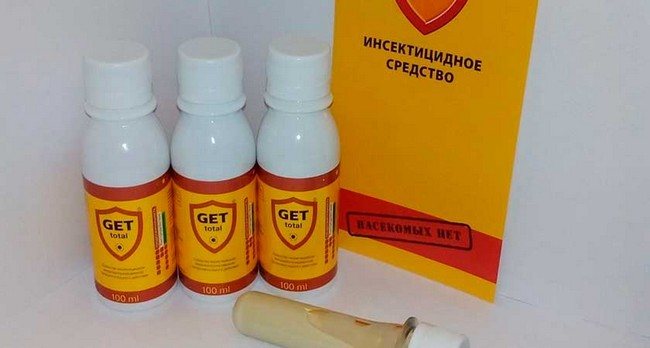

Such simple preventive measures will prevent the spread of fleas among birds, which are dangerous to their health.
Fleas in chickens: how to fight on your own?
Since parasites have many specific biological characteristics, the fight against them is more difficult than with fleas in cats and dogs. For this reason, treatment and medicine are selected individually, in each case. Despite this, the scheme has been worked out for years and, with a competent approach, does not fail.
The range of insecticidal anti-flea products is now large.They are predominantly of the contact spectrum of action, destroying parasites, but harmless to poultry.
Common release options:
Drops - applied locally to the affected areas, in small quantities. The service life is a month. This is enough for the total extermination of adults and larvae that hatched later from eggs. Not applicable for chickens and poultry with weakened immune systems.
Aerosols - prolonged action on adult insects, they pollinate the whole bird.
Along with this, there are: powders (dusts), liquid emulsions... The main thing is to adhere to the dosages indicated in the instructions.
In small-scale farming, it is acceptable to use flea repellents shown to cats and dogs. It is important that chemistry does not enter the chicken's digestive system, which can cause poisoning or other side signs. The most problematic is to handle the livestock individually: each one needs to apply an insecticide to the withers and rub in.
Chicken feather eater: how to get rid of
Ants on strawberries - how to get rid of
To get rid of downy eaters in chickens, competent treatment and disinfection of bird habitats is necessary.
The infected bird is immediately isolated and treatment begins, healthy chickens are treated for prophylaxis with insecticides, a total general cleaning is carried out using disinfectants.
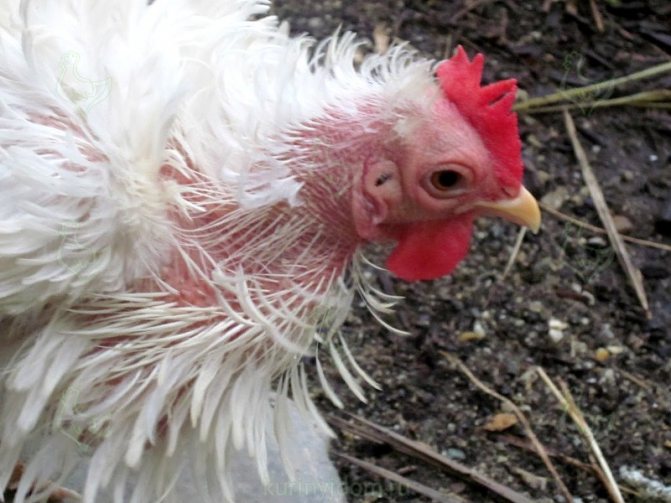

Feathering symptoms
Preparations for all types of parasites
Many farmers call Butox 50 the best drug for the treatment of downy eaters in chickens. It allows you to comprehensively treat chickens, premises and bedding by spraying. Chickens can even be bathed in its solution. It affects all types of ectoparasites and destroys them completely with one treatment, if it was carried out carefully. Diluted 50-100 ml of solution per hundred liters of water.
The Russian analogue of Butox is Delcid, the preparation for chickens can be used, like Butox, for the complete treatment of poultry and premises. How to use Delcid for chickens correctly can be found in the instructions for use. Another effective drug is Incur, the instructions for use for chickens suggest two treatments with a two-week break. The drug Operin has a similar effect. How else to get rid of chicken lice? Such preparations for pets as drops Bars and Stronghold will help, although they will have to be processed several times periodically.
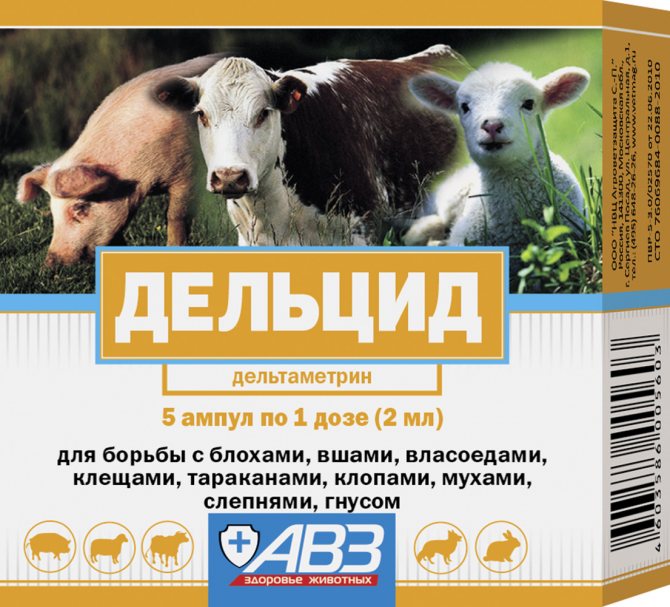

Delcid
The sprays of Frontline and Insectol, sprayed under the wings and tail of the hens, will help remove the peroed in chickens. Fleas and lice in chickens are excellently treated with preparations containing ivermectin, used in tablets and subcutaneously.
It is necessary to work with preparations, especially concentrated ones, with gloves, avoid contact with eyes, on the mucous membrane of the nose and mouth. If spilled, rinse with plenty of cold water. Store locked up and out of reach of children. Celandine Powder, applied under the wings of a bird, which has a deterrent effect, will also help to fight the lice.
All these preparations are suitable for the treatment and prophylactic treatment of adult livestock and young animals over the age of three months; they are too toxic for chickens.
Note! When using these drugs, you need to remember that they are all poisonous, the wrong dosage can be dangerous not only for the life of chickens, but also for human health.
Chicken flea chemicals
The most effective insecticidal pesticides used in the destruction of pests:
- Insectoacaricidal powder;
- Butox;
- Promectin;
- Frontline;
- Beafar;
- Stomazan;
- Leopard;
- Not anointed.
The last two options are contraindicated in layers due to their increased toxicity.
Butox
The drug is widely in demand on poultry farms and large farms. It is produced in the form of a water-soluble liquid, packaged in ampoules, with a volume of 1 ml. The main active ingredient in the composition is deltamethrin.
For the treatment of birds, 1 portion is diluted in 4 liters of water. Apply to feather composition by spraying. To do this, take special spraying devices.
Deltamethrin powder
Another effective insecticidal composition, with the same range of capabilities as Butox. The product is toxic, so when working with it, it is necessary to observe safety measures: put on a respirator on your face so as not to inhale harmful vapors.
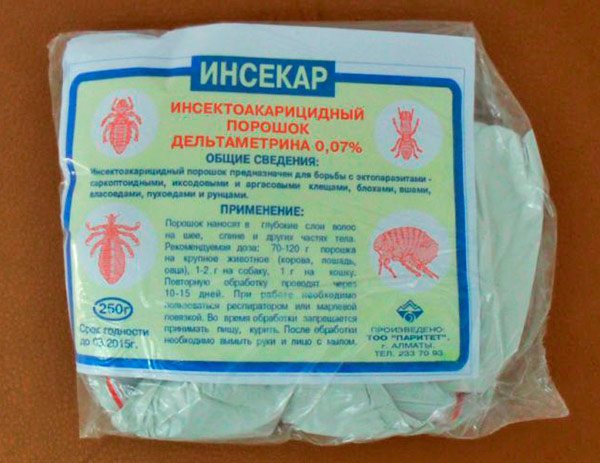

It is sold in the form of a powder, which is dissolved before use. Rubbed into the skin of a bird, spray feathers. The same solution is allowed to process the chicken coop.
Folk remedies for chicken fleas
In the early stages of flea appearance, it is acceptable to resort to folk remedies. Common:
- Table vinegar: diluted with water, in a 1: 3 ratio.
- Kerosene: each individual is processed by hand, and then transferred to another room.
- Gasoline-kerosene mixture on alcohol: mix the components in equal proportions, apply locally to the skin of the chicken, where there are accumulations of parasites.
- Herbal decoctions.
- Fresh strong smelling grass.
Due to the pungent odor that these products emit, the pests are expelled for a long time.
Herbs
Of the herbs that have a detrimental effect on fleas, they have:
- tansy;
- marsh wild rosemary;
- rosemary;
- sagebrush;
- geranium;
- lavender;
- tansy;
- Dovlatovskaya chamomile;
- potato grass.
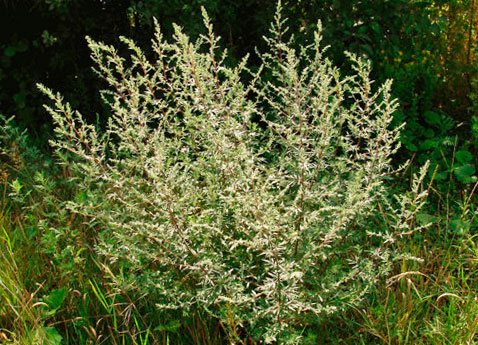

Herbal bunches are hung in the corners, and the walls are sprayed with kerosene or another strong-smelling liquid agent. This technique serves as a protective barrier against new invasions of parasites into the territory of the poultry house.
Decoction
Recipe for an effective herbal decoction against chicken fleas and lice:
- Combine herbs: chamomile flowers, wild rosemary, tansy. Each component is taken in 200-250 g.
- Brew with boiling water, in the amount of 5-6 liters.
- Boil for 15-20 minutes, cool.
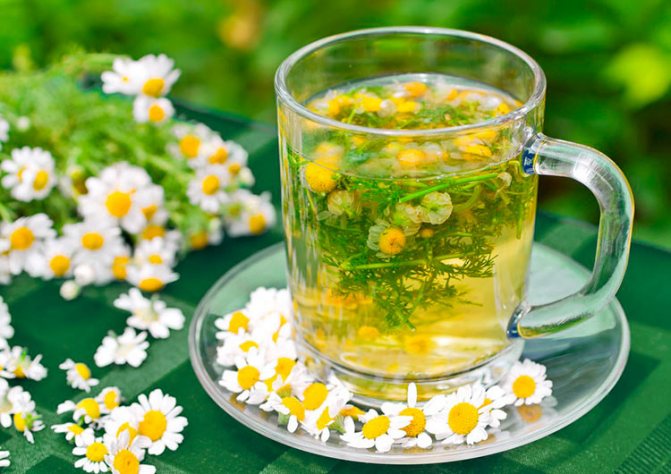

The resulting broth is used to pollinate the interior of the bird's house.
Ash
As a prevention of flea infestation, sand and ash baths, which are installed inside the poultry house and on the territory of the corral, will serve. At the request of the birds, somersaults in them, thereby disinfecting the feathers.
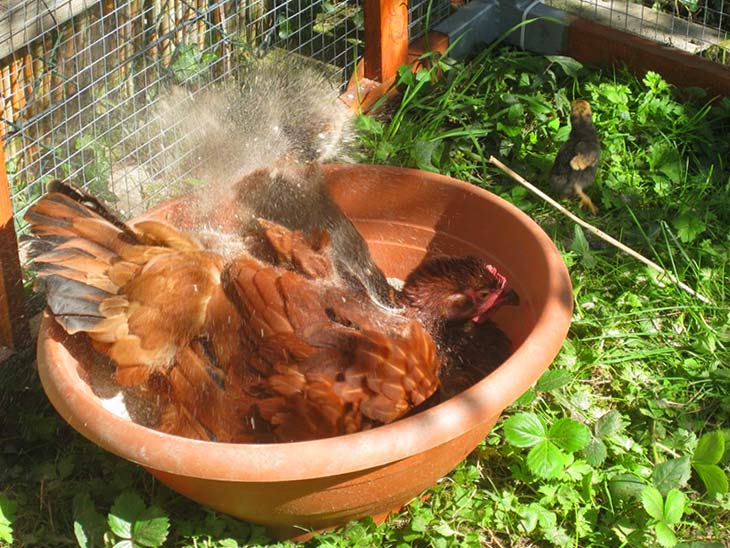

Red chicken mites
The red chicken mite, which got its name from the color of its small body, belongs to the class of blood-sucking parasites. It is a carrier of various viruses, bacteria, spreads the causative agent of cholera, typhoid, borreliosis, spirochitosis.
The body length of the parasites does not exceed 0.6–0.7 mm. The color of the body is dark brown, brownish red. After the blood mite has drunk blood, the body turns purple. The female is capable of laying 15–20 eggs per day. The maximum period of activity of red chicken mites is from May to mid-October. Parasites have a complex life cycle that includes several larval stages and depends on environmental conditions. Its duration is 6-13 days.
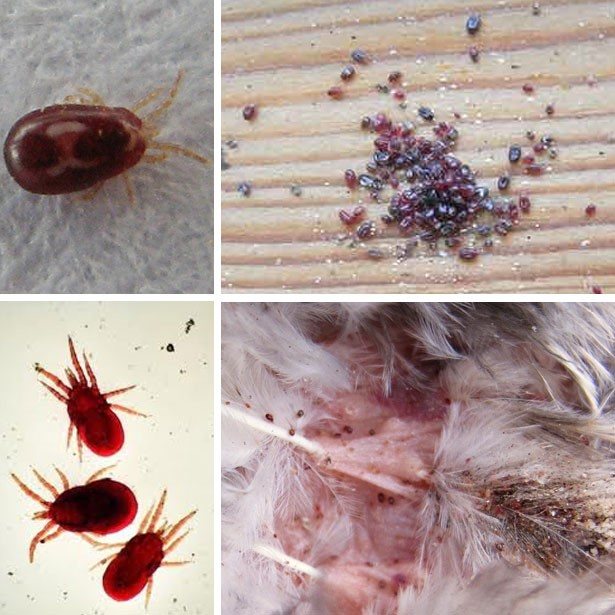

Red chicken mite
The blood-sucking parasite prefers a warm, humid microclimate. It lives in damp, humid, poorly ventilated areas. The maximum accumulation of chicken mites can be seen in the litter. At the same time, it is not so difficult to detect parasites. Some chicken mites are constantly on the surface of the body of an invaded bird, others live in chicken coops, poultry houses, hiding in the litter, under perches, in cracks on the walls, floor and with the onset of night they leave their shelter in search of a new victim.
Advice! If the chickens are reluctant to enter the hen house, equip new nesting places, experience severe itching - these are clear signs of bird infection with red ticks.
The red chicken mite feeds on blood by biting and damaging the skin. The bird experiences discomfort, itching, and anxiety.The condition of the feather cover is greatly deteriorating, the immunity is weakening, anemia develops, which can cause the death of the invaded feathered wards.
Dangerous pests enter the farms with the newly arrived livestock of chickens. Parasites can spread with household items and equipment. Most often, red ticks live in premises, backyards with unsatisfactory sanitary conditions.
Infection is facilitated by high humidity in poultry houses, the absence of sand baths for females, and a high density of birds in a confined space. It is worth noting that red chicken mites are dangerous to humans. They cause severe itching and allergies.
When day-old chicks are settled in poultry houses with ticks, a high mortality rate is noted. Chicks die from exhaustion, anemia within 5-7 days.
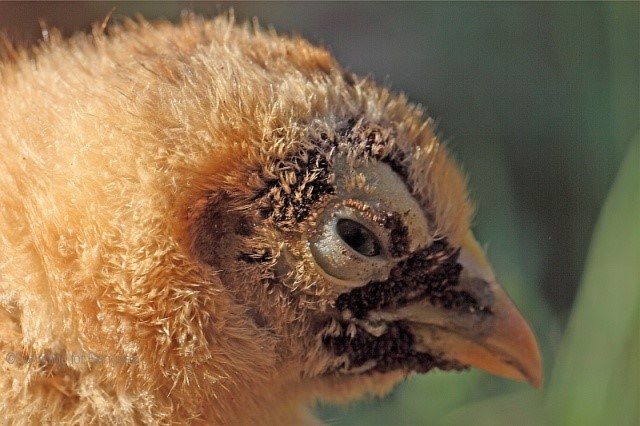

Strong chicken infestation with chicken mites
How to treat fleas from a chicken coop?
Peritroids are recommended for sanitizing the poultry house - inexpensive and effective:
- Raid;
- Dichlorvos;
- Raptor;
- Leopard;
- Get;
- Cucaracha;
- Tetrix;
- Executioner;
- Karbofos.
Each species requires an appropriate approach. Aerosols are ready-made and do not require preparation. Liquid suspensions must first be dissolved in water. They are guided by dosages, according to the attached instructions. If chickens remain in place during sanitary work, it is recommended to use phosphorus and chlorine insecticides. After chemical treatment, it is forbidden to consume chicken products for several days, otherwise serious poisoning is inevitable.
Prophylaxis
Prevention is the same folk remedies used to prevent infection. The fundamental measures include:
- Containers with ash and sand are installed on the bird's territory. The daily taking of such baths by hens will serve as an effective sanitation.
- Cover the outdoor pen with a fine mesh net to prevent poultry from coming into contact with free birds. They often carry pests.
- In the barn, the existing through holes are closed up, through which small rodents penetrate inside.
- The chicken composition is regularly examined for fleas and other body parasites.
- Preventive sanitation is carried out.
Chicken fleas, lice and similar bloodsuckers should be disposed of as soon as possible, and everyone chooses the method independently. If you do not treat and do not adhere to preventive measures, infection of a bird flock is inevitable, pests spread very quickly. The most effective result can be achieved with an integrated approach: a combination of folk remedies and chemicals.
Precautions for handling
To achieve the greatest effect and not harm the health of chickens, before using liquids, sprays and other products.
Important! Read the manufacturer's annotation. During processing, make sure that the substance does not enter the respiratory tract of humans and birds. These drugs are intended for external use, if ingested, they cause severe intoxication of the body. People need to work with rubber gloves, medical masks, or respirators.

